When Perseverance Is Important for Both Dogs and Their Owners
Click here to read the complete article
188 – November/December 2019
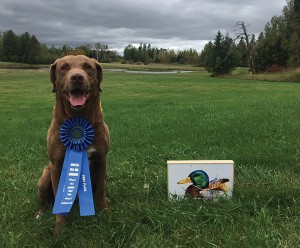 By Chris Robinson
By Chris Robinson
It is nearly as certain as death and taxes that if you do enough performance or field activities with enough dogs, sooner or later you will have a dog that seemingly has developed an unsolvable problem in that sport. Sometimes that issue will be so serious as to cause the dog to be unsuccessful in that activity. When that happens, if the dog is willing to keep trying, it is important to not give up on the dog because somewhere, somehow there may be something that will enable you and the dog to overcome that obstacle and succeed.
Sometimes, the dog’s problem results from an accident. That was the case with Scorch, Elaine Sperry’s Manchester Terrier, in agility. Poor Scorch had the misfortune of having the teeter bounce up and whack his testicles when he was running an agility course. Needless to say, he wanted nothing to do with that apparatus after it had attacked him!
“We absolutely had to retrain him on the teeter with a LOT of fun games. You can’t force a Manchester. Everything you want them to do has to be fun or they won’t do it. With Scorch, we also had to overcome his fear that the teeter would assault him again and that took a long time to accomplish. But I kept working with him because I wanted to fix the problem and I didn’t want to give up on my dog. Besides that, he didn’t quit trying and he loves to train so we just needed to make him feel safe and happy on the teeter again. We had to teach him how to handle a teeter in a way that he knew how to control it so it couldn’t smack him again. I played a lot of games on the teeter like him pushing the end down over and over and over. He stood
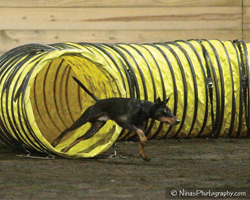 on the down end with a phone book under it in a two-on-two-off position. Then, I’d lift the teeter up and drop it an inch or two. We used lots of cookies and threw a ball as a reward and also to get the rapid movement of the teeter. Additionally, I used group play so he’d think that if the other dogs did it, it must be safe. Another thing I did was ‘take the show on the road’ doing teeters at other facilities, and I entered trials where I didn’t usually trial. The UKC trials were especially helpful as they permit equipment familiarization. So, I could go on the course before our run, do the teeter and leave to get cookies then do the same teeter again in our run for the judge. I think that was what provided the final breakthrough for Scorch,” Sperry said. Clearly this cure worked because Scorch is now UCh UCD URO1 UAG1 MACH Jetcity Dragon Fire Flyz CDX RAE MXS MJS MXF T2B3 CA CGC TKN RATM.
on the down end with a phone book under it in a two-on-two-off position. Then, I’d lift the teeter up and drop it an inch or two. We used lots of cookies and threw a ball as a reward and also to get the rapid movement of the teeter. Additionally, I used group play so he’d think that if the other dogs did it, it must be safe. Another thing I did was ‘take the show on the road’ doing teeters at other facilities, and I entered trials where I didn’t usually trial. The UKC trials were especially helpful as they permit equipment familiarization. So, I could go on the course before our run, do the teeter and leave to get cookies then do the same teeter again in our run for the judge. I think that was what provided the final breakthrough for Scorch,” Sperry said. Clearly this cure worked because Scorch is now UCh UCD URO1 UAG1 MACH Jetcity Dragon Fire Flyz CDX RAE MXS MJS MXF T2B3 CA CGC TKN RATM.
For Larry Sarek and his Chesapeake Bay Retriever AIRASRON 27 QAA, the issue that nearly permanently sidetracked the dog’s career as a field trial dog came about as the result of Ronny being an unskilled, too brave puppy. As just a baby puppy, Ronny, who is named for his owner’s U.S. Navy air squadron, managed to get in trouble in one of the Sareks’ ponds and only quick action by his owner who went into the water to rescue the pup saved him from drowning. The result was that the dog had a terrible fear of water, something that would haunt him even if his job-to-be had been hunting and not the highly competitive world of retriever field trials with its frequent long swims for both marked and blind retrieves. Then, the problem was compounded by mistakes made in his early training, primarily attempts to force the dog into the water without dealing with his fears. Finally, in desperation, his owner turned to a professional trainer who specializes in training Chesapeakes and has successfully fixed a lot of dogs’ problems for help.
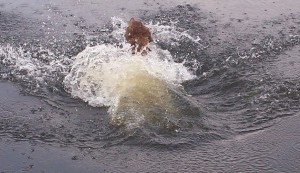 “I knew pretty early on that Ronny had some talent but he also had major issues,” said Craig Klein whose clientele consists of about half Chesapeake owners who want to run their dogs in hunt tests or field trials and half hunters, mainly Chesapeake owners, who want a trained hunting dog. “With Ronny, his biggest issue, of course, was not going in the water due to the mistakes made in his early training and his fear of water. When sent for either a mark or a blind, he danced around and acted confused. So, my first step with him was to revisit a basic training technique we use with retrievers called force-to-the-pile which, reduced to its simplest, means teaching a dog to run a straight line to a pile of bumpers that they can see, picking one up and bringing it back to me. We made this drill fun for him with lots of praise, pumping up his excitement level and, when he succeeded, making a big fuss over him. With dogs like this, it’s always very important to be their biggest fan cheering them on when they do something correctly; or if you are just starting to work on correcting an issue to be a big cheerleader if they are trying to do something correctly. When Ronny was happy doing the force-to-the-pile, we moved to the water force and spent a ton of time with him being creative and keeping it fun. I wanted to make going into the water after a bumper or a bird to be so much fun for him that the thought of not going would never enter his mind when he heard his name or the command ‘Back.’ I kept the training as fun and low pressure as possible with a lot of positive reinforcement for quite a long time. It was not until we knew that there was absolutely no doubt that he knew what was expected of him that we started to use any sort of strong correction if he didn’t go. By then, he handled those corrections very well because he understood them. With all dogs, but especially Chessies, any sort of strong correction will not be tolerated unless they understand the reason why they’re being corrected. When he returned to his owner last fall, he was ready to go on with his field trial training. This summer, the dog that was nearly a field trial washout won the qualifying stake at an all-breed retriever field trial so he’s now a qualified all-age dog which is a MAJOR accomplishment for any retriever but especially for a Chesapeake since the field trial game is dominated by Labradors and Lab owners and trainers.”
“I knew pretty early on that Ronny had some talent but he also had major issues,” said Craig Klein whose clientele consists of about half Chesapeake owners who want to run their dogs in hunt tests or field trials and half hunters, mainly Chesapeake owners, who want a trained hunting dog. “With Ronny, his biggest issue, of course, was not going in the water due to the mistakes made in his early training and his fear of water. When sent for either a mark or a blind, he danced around and acted confused. So, my first step with him was to revisit a basic training technique we use with retrievers called force-to-the-pile which, reduced to its simplest, means teaching a dog to run a straight line to a pile of bumpers that they can see, picking one up and bringing it back to me. We made this drill fun for him with lots of praise, pumping up his excitement level and, when he succeeded, making a big fuss over him. With dogs like this, it’s always very important to be their biggest fan cheering them on when they do something correctly; or if you are just starting to work on correcting an issue to be a big cheerleader if they are trying to do something correctly. When Ronny was happy doing the force-to-the-pile, we moved to the water force and spent a ton of time with him being creative and keeping it fun. I wanted to make going into the water after a bumper or a bird to be so much fun for him that the thought of not going would never enter his mind when he heard his name or the command ‘Back.’ I kept the training as fun and low pressure as possible with a lot of positive reinforcement for quite a long time. It was not until we knew that there was absolutely no doubt that he knew what was expected of him that we started to use any sort of strong correction if he didn’t go. By then, he handled those corrections very well because he understood them. With all dogs, but especially Chessies, any sort of strong correction will not be tolerated unless they understand the reason why they’re being corrected. When he returned to his owner last fall, he was ready to go on with his field trial training. This summer, the dog that was nearly a field trial washout won the qualifying stake at an all-breed retriever field trial so he’s now a qualified all-age dog which is a MAJOR accomplishment for any retriever but especially for a Chesapeake since the field trial game is dominated by Labradors and Lab owners and trainers.”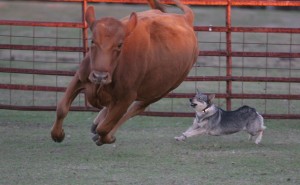
Pressure was a problem for David Clayton and his Swedish Vallhund GRCH WTCH SunFire’s Heads I Win PT HSAs RS-G RS-N who comes when “Penny” is called. Clayton said, “Vallhunds are very good stock dogs but if too much pressure is applied they will shut down. I was working with a trainer that did just that. He was trying to acclimate her to accepting pressure moving into corners and he applied too much pressure. She refused to work after that. She had already finished her advanced cattle and sheep titles and just needed her advanced duck title to finish her working trial championship. I had to start over from scratch and it was very incremental work. First I had to desensitize her to being close to the ducks without wanting to leave, then to start moving the ducks and working them. Then she needed to reestablish distance and finally to complete an advanced course. To do that I had to become creative and pair treats with proximity to the ducks. Once that was established, I began rewarding Penny for looking at the ducks. The next step was rewarding her for working the ducks and for moving into the corners. I used string cheese as the reward. It’s white and stands out and the dogs really love it. Gradually she came back to working the ducks happily but it took a year of retraining for her to be able to trial and complete her advanced duck title and her WTCH.”
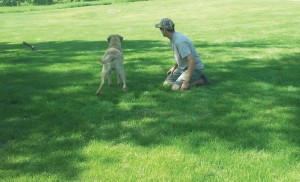 Marie and Jim Murphy’s problem with GCh MACH3 Karlshof KiedrowSKY MXJ PAD MJG PJD XF T2B2 ONYX CGC TKN , their Miniature Schnauzer, was caused by their own training error. “We let Kie run up the teeter in agility long before we should have. The result was a problem with the teeter for him and we had to re-train him with a wobble board and a low incline board first with no movement and then with movement. It took several months and we made our share of mistakes along the way. Fortunately Kie is motivated by food and, of course, love. We used a lot of high value treats in training and positive reinforcement and we finally succeeded in overcoming his issues with that obstacle,” Marie said.
Marie and Jim Murphy’s problem with GCh MACH3 Karlshof KiedrowSKY MXJ PAD MJG PJD XF T2B2 ONYX CGC TKN , their Miniature Schnauzer, was caused by their own training error. “We let Kie run up the teeter in agility long before we should have. The result was a problem with the teeter for him and we had to re-train him with a wobble board and a low incline board first with no movement and then with movement. It took several months and we made our share of mistakes along the way. Fortunately Kie is motivated by food and, of course, love. We used a lot of high value treats in training and positive reinforcement and we finally succeeded in overcoming his issues with that obstacle,” Marie said.
So, perseverance, patience and a willingness to try a lot of different things are almost always the most important keys to success in overcoming a dog’s issues. While he trains sporting dogs for the field, Klein has had enough experience with dogs in general to offer suggestions to people facing what may seem to be impossible obstacles in training for any performance event. He said, “Here are the steps we take with dogs that are having issues and I’m virtually certain it’s valid no matter what sort of activity or sport you are trying to do with a dog:
• Back up to the beginning and start over.
• Slow down and take baby steps in the dog’s training. Don’t move on to the next step until it’s clear the dog has mastered the step you’re working on.
• Always err on the side of using less pressure. Don’t fail to let the dog know how pleased you are when they do something correctly.
• Success breeds success so make sure the dog is succeeding at some aspect of the training and that each training session concludes with some success or another so you can end on a happy, positive note for the dog.
• Incorporate activities in training that build a dog’s confidence.
• Earn the dog’s trust.
• Keep things as fun as possible for the dog.
• Play to the dog’s strengths. With sporting dogs doing field training, this often means lots and lots of birds.
• Be creative in your training.
• If necessary, re-prioritize your goals.
• Seek help from a professional trainer who has a solid reputation for fixing problem dogs.
Finally, if the dog keeps trying, don’t give up. There’s almost always something that can be done to overcome the problem.”

Short URL: https://caninechronicle.com/?p=174369
Comments are closed











